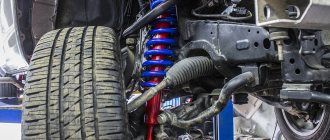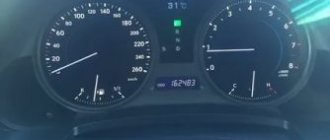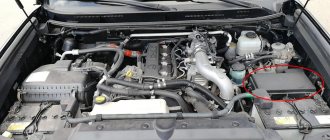The rear air suspension of the Prado 120 is quite common. Unlike the classic spring design, rubber cylinders filled with air are installed here. A system capable of changing hardness was also installed on the Toyota Land Cruiser 100, but its operation was ensured by a special fluid. In the Prado, this function is performed by compressed air .
The advantage of this suspension is that the ground clearance does not depend on how loaded the Prado 120 is.
The position of the body is closely monitored by two sensors, thanks to which the pneumatics maintain the required height. The adjustment occurs automatically; in addition, the driver has the opportunity to choose one of the three available operating modes . This allows you to increase off-road capabilities or improve handling on asphalt at the right time.
Prado 120 air suspension control
General arrangement of the rear axle air suspension.
The Prado 120 air suspension is controlled using a switch block . There is an “OFF” key on it, which turns off the automatic mode, and a knob that allows you to select one of the manual control options: high (HI), medium (Normal) and low (LO).
In HI mode, the ground clearance increases by 30-40 mm (the amount depends on the modification). This takes 15-20 seconds. In low LO mode, the Prado body squats by 30 mm in 10-15 seconds.
Air suspension switch block
When automatic control is activated and the flag is turned to Normal mode , at speeds over 50 km/h the suspension will be in the middle position. If you drive slower, the ground clearance will increase as much as possible. When driving less than 12 km/h, the ground clearance will drop to a minimum, and vice versa.
How to remove the ignition switch
If the Prado 120 ignition switch is jammed, you will need to remove it to identify the cause of the problem and the possibility of repair.
Instructions for removing the ignition switch:
- Disconnect the minus on the battery.
- Remove the plastic parts.
- The auto lock latch blocks extraction, so we turn the auto ignition key to ACC and press the latch button.
- Pull the ignition key towards you and remove the auto lock.
The video will tell you how to remove the ignition switch on a Prado 120.
Nuances of operation and adjustment of pneuma
, body roll to one side is often discussed . The reason for this is not a breakdown, but the inexperience of drivers and their laziness to study the operating instructions. Some owners go to a car service center with this problem; they are very lucky if they come across an honest mechanic who will explain everything and will not force them to pay for the “repair”.
We are talking about the roll of the car after parking on an uneven surface. To prevent this from happening, you need to turn off the automatic switching mode of the Prado 120 air suspension before parking on uneven surfaces or when jacking up the car.
If this is not done, then during subsequent parking the body will warp. This happens because at the moment the engine starts, the control system reads the position of the suspension at the moment and remembers it , taking it as horizontal.
If the situation is skewed, adjusting the air suspension of the Prado 120 will correct it.
- Place the Prado 120 on a flat surface.
- By pressing the “OFF” key, turn off automatic mode switching.
- Turn off the engine.
- Start the engine again and press “OFF” to activate the automatic mode selection system.
Operation of the Prado 120 air suspension off-road
When towing the Prado 120 , turn off the automatic suspension mode and set it to the “Normal” position. When driving off-road, turn off automatic mode selection and move the switch to the “HI” position.
The manufacturer prohibits the use of the pneumatic control system in frosts below -30°. When operating in such weather conditions, it is necessary to turn off the automation and set the body to the middle position.
What is the reason for the breakdown of the Land Cruiser Prado 120 ignition switch?
When the ignition switch turns in a Toyota Prado 120, the reasons may be as follows:
- the auto-lock itself is very long, which means the bar is also long;
- large heavy wheels;
- contacts have oxidized or melted;
- key wear;
- wear of the internal elements of the auto lock;
- The core of the auto lock is worn out.
The lock has a “steering wheel jamming” function built into it. If, when the steering wheel becomes wedged, you do not loosen it and try to turn the key, you will need to exert considerable effort. Therefore, it is recommended to loosen the steering wheel. The Toyota Prado 120, which has large, heavy wheels, does not allow the steering wheel to be loosened to the required level. In this case, the rod receives additional load and breaks.
Wear of the auto lock core is a rare occurrence; the solution to the problem is to replace the cylinder with a new one. Finding the right part is not difficult, since the necessary spare parts are always available in car dealerships and service centers.
The contacts melt or oxidize due to moisture or simple aging.
During the operation of the car, parts wear out. The natural process requires a complete replacement of the auto lock or a detailed one, for example the core.
Key wear is a fairly rare cause. But if this happens, the larva will also need to be replaced.
Diagnostics
To avoid unpleasant surprises on the road, it is necessary to regularly diagnose the Prado 120 air suspension . For self-diagnosis, there is a connector in the interior of the SUV. And the technical instructions for the Prado 120 describe this process in detail.
Prado120 technical documentation and instructions can be found here.
Technical instructions Prado 120
It is useful to visit a car service center from time to time to check the air suspension of the Prado 120. The following signs :
- when the engine is not running, the car sags;
- one of the selected manual modes is not held;
- the valves in the electromagnetic block are not sealed;
- after starting the engine, the front or rear of the car rises.
First, computer diagnostics . Check the serviceability of the system, valves and sensors. Then the mechanic checks the pneuma for external defects and eliminates them.
Diagnostic connector
Monitor the condition of the air suspension. A fault detected in time will help you avoid unpleasant surprises on the road.
Which anti-corrosion agent to choose?
Anti-corrosion agents are divided into two types: compositions for wheel arches/bottoms and anti-corrosion agents for hard-to-reach places.
Compositions for hidden cavities
Such funds are characterized by fluidity, because used to treat hard-to-reach areas of the car. Fluidity gives the composition the opportunity to seep into micropores and the slightest cracks, impregnating rust stains.
A high-quality anti-corrosion agent for the Prado 120 should dry quickly, turning into a high-strength protective film. If drying is not fast enough, the composition will drain from the treated elements, leaving them without protection.
Hard-to-reach car cavities are much more difficult to prepare for the application procedure than the frame or underbody. Therefore, anticorrosive agents for hidden areas must have the property of displacing the causes of corrosion. If it penetrates into the layer of rust and microcracks, the product displaces particles of water and saline solution from them.
Anticorrosives for the bottom
The main property of such compounds is increased strength, since during operation the bottom and arches of an SUV are subject to constant impacts and abrasives.
Anti-corrosion compounds with thixotropic properties are highly valued. This anticorrosive agent does not leave streaks when applied, and after drying it forms a high-strength film that protects the bottom from peeling and abrasion.
Resistance to salts is also considered an important indicator for an anti-corrosion agent, since in winter the wheel arches and underbody of a car are constantly exposed to road reagents.
Due to the high viscosity of the anticorrosive agent, processing of Prado 120 arches is often carried out with a special gun. Thick mastic does not penetrate rust stains and microcracks well, so thorough cleaning of the surface is required before application.
Prado 120 air suspension design
The air suspension control system (ANS) consists of the following mechanisms.
- ABS control unit for Prado without pneuma.
- Door position limit switches.
- Speed sensors.
- ANS system relay .
- Pneumatic cylinder.
- A sensor that determines the amount of ground clearance.
- Air valve Prado 120.
- Control valve.
- Bypass valve.
- Release valve.
- Air filter.
- Trunk opening sensor.
Air suspension control system (ANS)
pneumatic indicators and switches on the dashboard:
- ANS system mode indicator .
- Pneumatic on/off indicator.
- ANS control unit .
- TEMS control unit .
- Connector for diagnostics.
- Stop signal switch limit switch.
- Flag for switching pneumatic modes.
- Air switch " OFF ".
Pneumatic indicators and switches
The Prado 120 air suspension system also includes the following mechanisms :
- block that controls electrical equipment (receives information from limit switches and redirects it to the AHC );
- ABS control unit (sends information from speed sensors to the ANS );
- ANS system control unit .
Compressor
The Prado 120 air suspension compressor consists of an air dryer, an exhaust valve and the compressor itself . Let's look at the purpose of each of these parts.
Compressor device
The compressor supplies air to the air cylinders that lift the body. It only works when the engine is running. The name of the exhaust valve speaks for itself - air comes out through it when the body is lowered. There is always some amount of water vapor in the air. A dehumidifier is used to remove condensate from the system.
Receiver
The receiver is composed of a valve block and an additional air tank . The air released by the pneumatic cylinder temporarily accumulates in an additional container. This reduces the time spent changing the suspension height.
Receiver device
The Prado 120 air suspension valve block consists of three elements:
- bypass valve - serves to bypass air between pneumatic cylinders;
- control valve – connects the compressor and the pneumatic cylinder;
- pressure relief valve – connects the pneumatic cylinder and additional capacity.
Body position sensors
These mechanisms are located on the Prado 120 air suspension and are responsible for determining the height of the body above the road.
The design of body position sensors
The body sensor of the Prado 120 is designed simply. The shaft is connected to a brush that runs over a resistor. The interaction of the resistor and the brush forms resistance; it has a variable value and depends on the angle at which the sensor shaft is rotated. When the brush is rotated, the output voltage also changes.
Pneumatic cylinder
A pneumatic cylinder maintains the body at a given height, raising or lowering it as necessary. The pneumatic cylinder ensures smooth operation. Structurally, this is a separate air chamber containing compressed air.
Pneumatic cylinder
Link to replacing the Prado 120 air spring.
Description of the air suspension control system
Many Toyota Land Cruiser Prado models were equipped with rear air suspension. This type of suspension uses rubber pneumatic cylinders instead of rear springs. The main difference between this suspension is that it runs on compressed air compared to the Land Cruiser 100, which runs on a special working fluid.
Using two body height sensors, the air suspension automatically adjusts the height, depending on the number of passengers and cargo weight. In addition to automatic adjustment, you can manually set three modes of operation of this system, which significantly improves the vehicle's handling and maneuverability.
| Location of air suspension control system components. 1 — pressure modulator/ABS control unit (models without VSC), 2 — side door limit sensors, 3 — front wheel speed sensors, 4 — “AIR SUS” relay, 5 — pneumatic cylinder, 6 — body height control sensor, 7 — solenoid valve for releasing pressure in the pneumatic cylinder, 8 — control valve, 9 — bypass valve, 10 — exhaust valve, 11 — air filter housing, 12 — rear door limit switch. | |
| Location of air suspension control system components (instrument panel). 1 — suspension operating mode indicator, 2 — air suspension “OFF” indicator, 3 — air suspension control unit, 4 — vehicle control system control unit (models with VSC), 5 — diagnostic connector, 6 — brake light switch, 7 — suspension operating mode switch, 8 — switch for automatically changing the air suspension operating mode (air suspension “OFF” switch). |
The components of the rear air suspension are:
1) Air suspension operating mode switch block
Includes an automatic body height control switch (“OFF”) and an air suspension operating mode switch. There are three suspension operating mode options: “HI” (high) mode, necessary when driving off-road, “Normal” (medium) and “LO” (low) to facilitate entry/exit of passengers and when loading/unloading the vehicle.
When selecting the “HI” mode, the car body rises by approximately 30-40 mm (depending on modifications) within 15-20 seconds. When selecting the “LO” mode, the car is lowered by 30 mm relative to the normal state (within 10 - 15 seconds).
Also, in addition to manual mode switching, there is automatic mode switching:
a) If, when the car is moving in the “Normal” mode, the speed is reduced to 12 km/h or less, the suspension will automatically move to the “LO” position, and vice versa.
b) If you reduce the vehicle speed to 50 km/h (in “Normal” mode), the system will switch to “HI” mode. And if you accelerate to 50 km/h while driving in the “HI” range, the system will automatically return to the middle position.
2) Air suspension control system indicators
The suspension operating mode indicator informs the driver about the selected operating mode of the system.
The control system's "OFF" indicator lights up if the automatic air suspension control is turned off by pressing the corresponding switch. If the indicator flashes, there is a malfunction in the air suspension system. This indicator is also used to read diagnostic trouble codes.
3) Air filter assembly
It consists of the filter itself, which is necessary to clean the air taken in by the air suspension from dust and sand, and an expansion chamber, which serves to reduce noise during air intake. The air filter draws air from inside the car. He doesn't understand. If you need to replace the filter itself, replace its entire housing assembly.
4) Compressor assembly
Includes the compressor itself, the exhaust valve and the dryer.
a) The compressor supplies compressed air to the pneumatic cylinders necessary to lift the body. To avoid battery discharge, the compressor operates only when the engine is running.
b) The exhaust valve is necessary to vacuum the pneumatic cylinders when the height of the body is reduced.
c) A dryer is necessary to remove moisture from the compressed air pumped by the compressor and when air is released by a valve from the pneumatic cylinders into the atmosphere.
5) Pneumatic cylinder
The pneumatic cylinder consists of a separate air chamber filled with high pressure compressed air to ensure better running smoothness. Necessary to support the body and change its height.
6) Air suspension receiver
Consists of an additional reservoir and a block of solenoid valves.
An additional reservoir temporarily stores the air escaping from the pneumatic cylinder, which helps reduce the time required to reduce the height of the body.
The electromagnetic valve block includes: a bypass valve (passes compressed air between the left and right pneumatic cylinders), a control valve that serves to connect the compressor and the pneumatic cylinder, and a pressure relief valve (for releasing air from the pneumatic cylinder into an additional tank).
7) Body height control sensors
Sensors determine the height of the body and are located on the left and right sides of the rear axle.
The sensor consists of a brush connected to a shaft, which slides over a resistor that forms a support plate. Because The resistance value between the brush and the resistor changes depending on the rotation angle of the sensor shaft, then the output voltage also changes due to the rotation of the brush.
In addition to the above components, the body height adjustment system uses the following elements:
a) Side door limit sensors (detect door closing);
b) Rear door limit sensor (detects the closing of the rear door);
c) Body electrical control unit (receives a signal from the limit sensors and sends information to the air suspension control unit);
d) “AIR SUS” relay (supplies current to the receiver of the air suspension control system);
e) Front wheel speed sensors (determine vehicle speed);
f) ABS system control unit (sends the signal received from the wheel speed sensors to the air suspension control unit);
g) Air suspension control unit.
Features of operating vehicles with air suspension
The problem of vehicle roll during operation is quite often discussed on various forums. In most cases, the essence of the problem is not in any malfunction, but in the system configuration features. The problem is the car rolls at stops while the engine is running. Many owners, turning to service workshops with this problem, receive quite interesting answers, and sometimes bills.
When carrying out work that requires jacking up the vehicle, as well as before parking on uneven areas (curbs, snowdrifts, holes), it is necessary to disable automatic mode switching.
If this rule is not followed, one side of the car will constantly lower when the car is parked. This is due to the fact that, when starting the engine, the air suspension control system takes the position in which the car is located as horizontal. In order to fix this problem, you need to do the following:
a) Stop the car on a level surface.
b) Turn off the automatic mode switching system by pressing the “OFF” switch (the corresponding indicator should light up).
c) Stop the engine.
d) Start the engine and turn on the automatic mode switching system by pressing the corresponding switch again.
When towing a car, you must set the body height to average and disable automatic mode switching.
When driving on very uneven roads or when crossing a ford, you must set the mode to “HI” and disable automatic mode switching.
Toyota also does not recommend using the air suspension control system at temperatures below -30ºС. If you operate your vehicle at these temperatures, set the vehicle's ride height to medium and disable automatic mode switching.
The translation was prepared by Lyudmila Chechel, an employee of the Legion-Avtodata publishing house © 1999 – 2010 Legion-Avtodata
Front suspension diagnostics
The front suspension of the Toyota Land Cruiser Prado is independent and double wishbone on the axles. It can be equipped with either a regular cheap one or an expensive pneumatic one. Depending on driving, pneumatic cylinders will last up to 140,000 km, and a pneumatic compressor about 180,000 km.
Description of the front suspension of the Prado 120. It consists of:
- double wishbone;
- ball joint;
- internal and external CV joints;
- flavoring;
- springs;
- suspension rods.
To make a diagnosis, you must do the following:
- We clean the bottom of the car.
- We remove the height control sensor, since the wires are not located very well, they can get moisture, dirt, etc.
- We also clean the frame and suspension from dirt, salts and corrosion.
- We perform maintenance on pneumatic cylinders and clean electrical contacts.
- We cover all suspension elements and its sealing materials with an anti-corrosion layer.
This completes the diagnostics.
For a visual representation, below is a diagram of the front suspension of the Prado 120:











